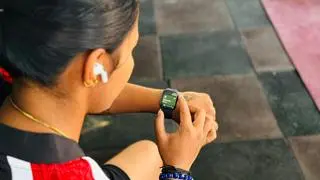LG has been obsessed with the idea of more than one screen on a phone for many years now. Quite recently, they came out with two phones that double the screen power in totally out-of-the-box ways. One of these is the LG Wing that has a never seen before swivelling second display, and the other is the LG Velvet which has an accessory that gives it a second screen. They’ve done this before with their G8x and some other devices, and now here’s the same format again on the LG Velvet, which we’ll look at now.
The LG Velvet is a nice enough Android phone by itself. Design-wise, it has got a shiny reflective back that catches light prismatically. The colour we saw was Aurora Silver. If you like shiny things, you’ll love it. It’s a really tall and big phone and with the case, quite heavy and clunky.
Twice the screen
The main screen is a 6.8-inch one and has a very nice 1080x2460 pixels P-OLED display. No special refresh rate or anything, but just a nice display. It has a dated looking notch instead of the punch hole that’s more popular now. The bezels on this display are not exactly negligible but they’ll certainly do. The sides of the screen are prominently curved, which looks nice, but can make it difficult when you need to touch something specific tucked into the side — like the menu that’s part of the interface.
But now, here’s where things get interesting. If you opt for its accessory, this phone gets an entire other screen. This comes about via a hard plastic flip case where the phone itself fits on the right side and a second screen on the left. Between the two is obviously just the spine of the case itself. With this second display you’re able to open up two apps and view them full screen side by side. I couldn’t find a way to use split screen on top of that or one would have been able to open up several and probably have a brain implosion with all the multi-tasking. Strictly speaking, there’s a third screen around: that’s a small windowed display on the cover to show the time and other info when the case is shut.
With all the implementations we’ve seen recently with folding phones, it is interesting to see one that just sticks two screens together without actually working on the software for these to work in tandem. You can opt to turn off the left display and focus on one thing and save some of the battery but then you won’t get any interested curious glances. There’s a menu for you to swap the screens or turn off one or the other. There is a bit of customising for two screens, but it’s really minimal. So, if you open up two versions of an app like YouTube, it will switch off from one screen. If you use LG’s game controller, some games can be played with one screen becoming the controller and the other the display. I didn’t locate a way of making one screen a keyboard, else that could have been interesting. The two screens don’t meet in the middle as one — they really are and feel separate.
There are also some strange choices for the left screen. It does let you use a camera, but that will not work for a selfie as the front camera is actually located on the right screen. Even so, the left screen has a notch, perhaps just for aesthetics and symmetry. The cameras are a 48MP primary, an 8MP wide angle and a 5MP depth. The front camera is a 16MP. They perform adequately, subduing colours at times and not doing too much for low light photography but in other ways averagely good.
This phone’s specs in India include a Snapdragon 845 which while an older processor is still a flagship one and good enough for most things. There’s 6GB of RAM and 128GB of storage with expansion possible via SD card.
While this is an interesting phone and unique in its two-screen style, LG has had a long time to iron out problems that could have taken the format much much further.
Price : ₹43,990, ₹44,990 with accessory
Pros : Unique accessory for a two-screen experience, decent specs, retains extras like the headphone jack and memory card slot, smooth performance, old but stil powerful chip, great screens, sturdy solid build
Cons : Heavy, tiring to hold, software isn’t leveraging two screens enough because they’re separate, some baffling ergonomic choices.









Comments
Comments have to be in English, and in full sentences. They cannot be abusive or personal. Please abide by our community guidelines for posting your comments.
We have migrated to a new commenting platform. If you are already a registered user of TheHindu Businessline and logged in, you may continue to engage with our articles. If you do not have an account please register and login to post comments. Users can access their older comments by logging into their accounts on Vuukle.